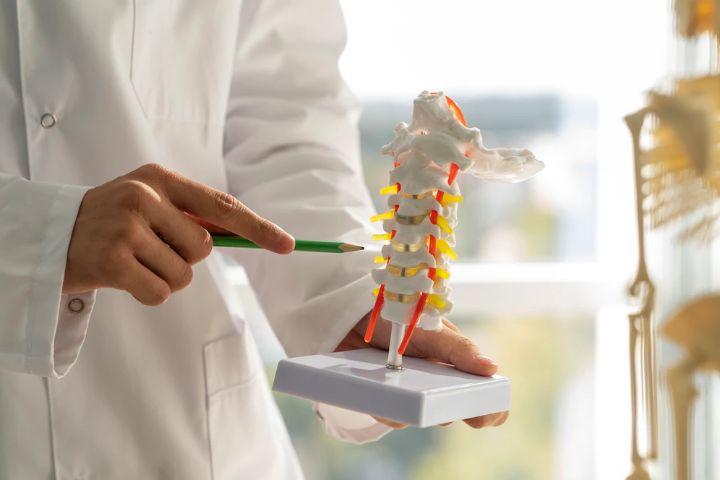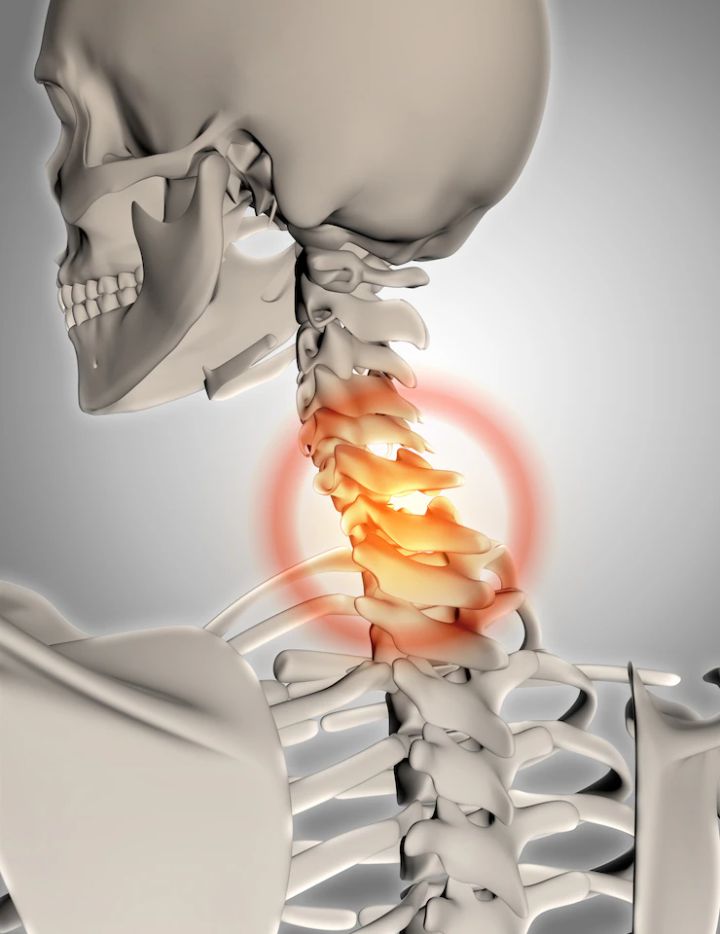Cervical radiculopathy is a condition characterized by nerve irritation caused by damage to the cervical spine’s nerve roots. This damage can occur due to various factors, such as disc herniation, age-related wear and tear, spinal stenosis, or trauma to the neck.
Symptoms may include pain spreading into the arm, neck, chest, or shoulders, a tingling sensation, muscle weakness, or numbness in the hand or fingers. While it can cause significant discomfort, it’s treatable through various methods like physical therapy, medication, injections, and in severe cases, surgery. If left untreated, it can potentially lead to chronic complications.

Photo Credit: Freepik
You may suffer from cervical radiculopathy if you experience neck pain, discomfort, or weakness in your arms. This condition occurs when the nerves in your cervical spine become compressed or irritated.
A common symptom of cervical radiculopathy is radicular pain, which is a sharp, shooting pain that radiates down your arm. This pain can be intense and may be accompanied by weakness or numbness in your arm.
Another symptom of cervical radiculopathy is numbness and tingling in your arm, hand, or fingers. This sensation can range from a mild pins-and-needles feeling to a complete loss of sensation.
Your brachial plexus is a network of nerves transmitting signals between your neck and arm. When the nerves in your cervical spine become compressed or irritated, this can affect the functioning of your brachial plexus, leading to a range of symptoms.
To diagnose cervical radiculopathy, your doctor may perform a physical examination to assess your neck and arm for weakness, sensation, and reflexes. They may also ask about your medical history and any past injuries or conditions that could be contributing to your symptoms.
Your doctor may order imaging tests, such as a cervical MRI, to see the spine and detect any abnormalities, like a herniated disc. They may also order an electromyography (EMG) to evaluate the electrical activity in your muscles and a nerve conduction study (NCS) to assess the function of your nerves.
A cervical MRI is a non-invasive imaging test that uses a powerful magnet and radio waves to produce detailed images of the cervical spine. This test can show any abnormalities present in the intervertebral discs, nerve roots, and spinal cord. It is a painless procedure that does not use radiation.
It is important to note that cervical radiculopathy can progress to a more severe condition called cervical myelopathy. This occurs when the spinal cord is compressed, leading to muscle weakness, loss of coordination, and difficulty walking. If your doctor suspects cervical myelopathy, they may order additional tests, such as a cervical CT scan or myelogram, to further evaluate the spine.
An EMG and NCS may be ordered to help diagnose cervical radiculopathy and determine the exact location of the nerve compression. An EMG measures the electrical activity of your muscles, while an NCS assesses the nerve function and conduction speed. These tests can help your doctor determine the nerve damage’s severity and the most appropriate treatment plan.

Photo Credit: kjpargeter
Cervical radiculopathy can be caused by a variety of factors, including:
Here are some pain management techniques that may help:
Cervical decompression is another therapy that may help relieve radiculopathic symptoms. This therapy involves gently stretching the neck to create space between the cervical vertebrae, reducing pressure on the nerves in the neck.
If these non-surgical treatments aren’t effective in managing your symptoms, your doctor may recommend other options such as:

Photo Credit: valuavitaly
If non-surgical treatments are not effective for your cervical radiculopathy, your doctor may suggest surgery. There are a variety of surgical options available in Australia that may help relieve your symptoms and improve your quality of life.
Cervical fusion is a common surgery for relieving neck and arm pain caused by cervical radiculopathy. During the procedure, your surgeon fuses together two or more cervical vertebrae to create a single, stable piece of bone. This helps to prevent movement between the affected vertebrae and can relieve pressure on the pinched nerve.
Cervical discography is a diagnostic tool used to help identify the source of your neck and arm pain. During the procedure, your doctor will insert needles into the discs in your cervical spine and inject a contrast dye. This allows your doctor to visualize the discs using X-rays or CT scans. If a disc is found to be causing your symptoms, your doctor may recommend surgery to remove or repair the damaged disc.
Cervical arthroplasty is a surgical option used to treat cervical radiculopathy caused by a herniated disc. During the procedure, your surgeon will remove the damaged disc and replace it with an artificial one. This helps to relieve pressure on the affected nerve and restore normal neck and arm function.
One pain management technique that may be helpful is stretching exercises that can improve your range of motion and alleviate muscle tension.
Additionally, cervical decompression therapies like cervical collars and cervical traction can help relieve pressure on your affected nerves. Cervical epidural injections can also be used to reduce pain and inflammation.

Photo Credit: bearfotos
If you want to prevent cervical radiculopathy, there are several things you can do. Here are some tips:
If you have already been diagnosed with cervical radiculopathy or are at risk due to underlying conditions, there are ways to manage those risks:
If you have been diagnosed with cervical radiculopathy, knowing you are not alone is important. Coping with the condition can be challenging, but strategies and support are available to help you manage your symptoms and improve your quality of life.
Living with cervical radiculopathy can be emotionally challenging, especially if you are experiencing chronic pain or disability. It is important to seek emotional support when needed and connect with others who understand what you are going through.

Photo Credit: Freepik
Self-care practices can help you manage your symptoms and improve your overall well-being. Here are some self-care strategies you might find helpful:
If you’re looking for more information and resources on cervical radiculopathy, Australia has a range of options available. Here are some resources you may find helpful:
Treatment for cervical radiculopathy involves physical therapy, medication, possible corticosteroid injections, or in severe cases, surgery. Your healthcare provider will guide you towards the most appropriate treatment.
Cervical radiculopathy is typically characterised by pain spreading into the arm, neck, chest, or shoulders, a tingling sensation, muscle weakness, or numbness in the hand or fingers.
The main causes of cervical radiculopathy include disc herniation, cervical spondylosis (age-related wear and tear), spinal stenosis (spinal canal narrowing), and neck trauma.
While not typically life-threatening, untreated cervical radiculopathy can lead to chronic pain, permanent nerve damage, and in rare cases, coordination problems or bowel or bladder control issues.